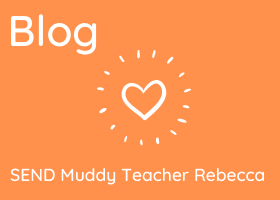Fear of Mud
By Muddy Puddle Teacher Rebecca Butland
If you’ve ever watched a toddler play – and I seem to spend a lot of weekends doing this at the moment – you will notice that they have no fear when it comes to mud. They love it! They add water, it goes over their shoes, over their clothes, their face – it gets everywhere! So, where does this early love of things that are messy disappear to?
I have recently been working with older children and found that they are really reluctant to touch mud or sometimes even go near it. I began to question why this was. I work with children with Special Educational Needs, so the first question I asked myself was whether it could be sensory? I know some of my children can struggle with new experiences and touching different textures? Having explored this further, this wasn’t always the reason (if you suspect this might be the reason, there is a great resource on the Muddy Puddle Teacher website called ‘Supporting a Love for Mud’).
I pondered this further…
Is it because they don’t know how to play with mud? Are we not playing outdoors as much? Are they not building a tolerance to getting dirty? Are children becoming anxious that, by becoming dirty, their parents would be angry? Could it be that they are worried about getting dirt onto other things? Is it that we have taught children that mess always needs to be controlled and getting dirty must have a purpose attached to it?
Fear of Mud: When encouraging outdoor play, how can we overcome and work around some of these fears?
There is the child whose parents has just bought them a new pair of shoes – why not ask them to have appropriate clothing at school such as wellies? Have they got waterproof suits or spare clothes? Are some children scared of getting cold and wet from the mud? Make sure that they have enough warm layers.
If children look scared when they splash mud onto themselves, why not splash it onto yourself! Teach them using dolls and show them that mud washes off. You can set up an outside bath and show how to wash feet or hands after getting them dirty. Maybe when they realise how easily it washes off this may help to reduce the fear.
If we model playing with the mud, the children are more likely to join in too – do some of our fears as adults rub off onto the children? If they don’t know what to do in the mud, you can provide lots of different tools to help support playing with mud. You can have different utensils, pots, pans, bowls, buckets. You could wash mud off a surface using different cloths. You can add flowers, grasses, petals, herbs. Why not have different tubes, funnels and sieves. It can be really uncertain for children being left with mud, so show them how to make mud pies and decorate them using things around them.
Let’s look at the positives. Mud is fun, mud creates memories, mud lets you build your own world, mud is free (and let’s face it – so many resources are so expensive!), mud has been proven to make you happy, it can reduce childhood stress and anxiety – and these are just a few of the advantages. Talk to parents about the advantages and show them the great amount of benefits that can be had.
Let’s embrace the mud and help children learn to love it – start by celebrating International Mud Day on the 29th June!
‘The world is mud-luscious and puddle-wonderful’ – E.E. Cumings
The Muddy Puddle Teacher
The new way to do Outdoor Learning
Teacher Training | Teaching Resources | Primary Resources
Muddy Puddles here you come!
EYFS | KS1 | KS2
Visit the woodland trust to find new ways to support nature. Tap this link!


